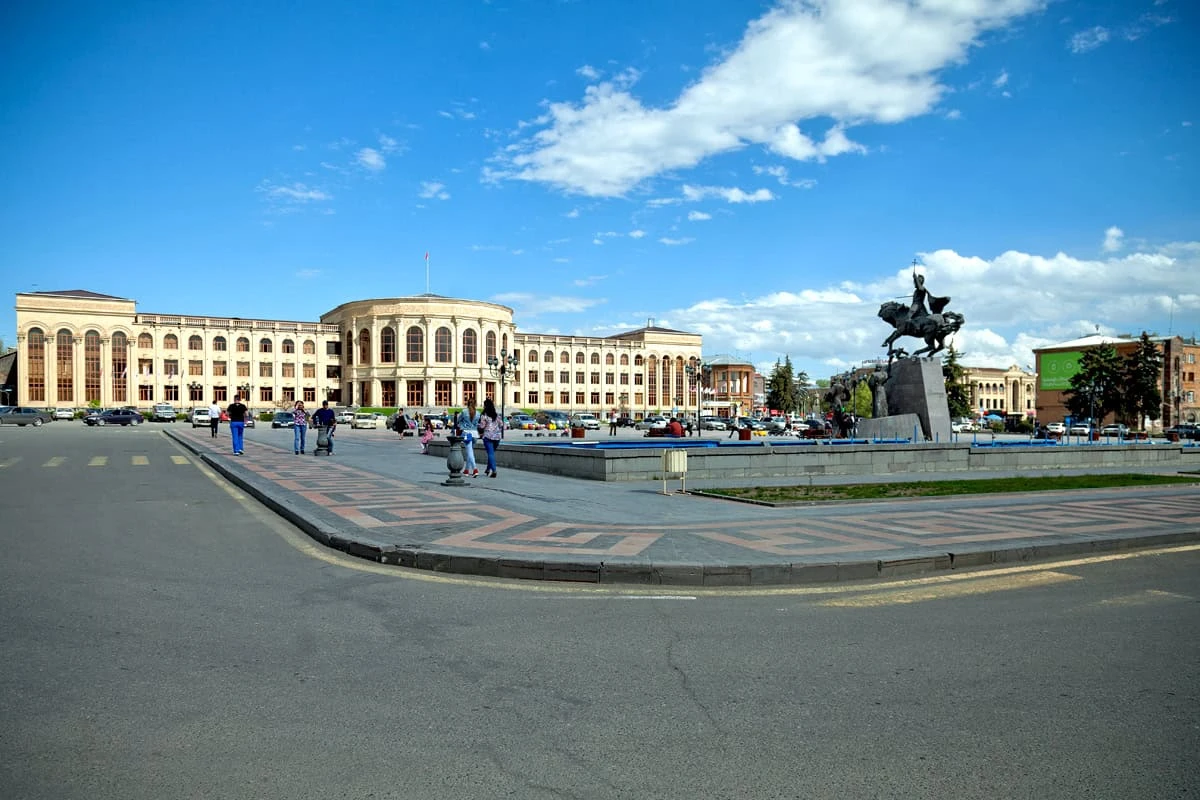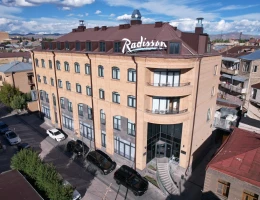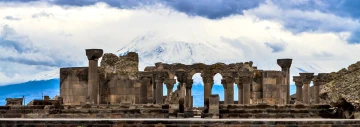Gyumri is the second largest and one of the most colorful cities of Armenia. It is called the cultural capital, and also the black city due to the buildings from volcanic tuff. It is pleasant to wander along the old streets, breathe fresh mountain air, get acquainted with Armenian history and culture.
In this article we will speak of what to see in Gyumri, what sights you can visit on your own, and where it is better to go by a tour.
Vardanants Square
Vardanants is the central square of the city, where several attractions are located. Therefore, tourists often start their route right from here.
The square was opened during the Soviet Period – in the 1930s. Initially, it was called the May Victories' Square. In 2008, a memorial dedicated to the Battle of Avarayr was placed in the center of the square.

Vardanants Square
In the center of the sculptural composition there is the figure of Vardan Mamikonyan, 5th-century commander, a national hero of Armenia, in whose honor the square was renamed. Other heroes who participated in the battle are depicted next to him.The Battle of Avarayr took place in the year of 451. The Armenians, led by Vardan Mamikonyan, rebelled against the Sasanyans' imposition of Zoroastrianism. During the battle, the Armenian commander died.
An important event in the life of the city was the arrival of Pope Francis in 2016. During his stay in Gyumri, he held a liturgy in the main square. Catholicos of All Armenians Garegin II also attended the event.
You can learn more about the history of Gyumri, Vardanants Square, as well as its attractions during the tour to Gyumri and Harichavank. Every Tuesday and Friday there is a departure from Yerevan.
Church of the Holy Mother of God

Church of the Holy Mother of God
The Church of the Holy Mother of God or "Seven Wounds" is located exactly on Vardanants Square. It was built in 1882-1887 on the site where once there stood a chapel in the 17th century, where, according to legend, the icon of the "The Seven Sorrows of the Blessed Virgin Mary" painted by one of Christ's disciples was kept.
The temple, built of tuff, looks very monumental. Its height makes 22 m. And the peculiarity of the building is the presence of several altars created for representatives of different faiths:- The main one – for the Armenian Apostolic Church;
- Seven Wounds – for the Russian Orthodox Church;
- Holy Trinity – for Catholics;
- Saint Sargis – for the Assyrians.
Services are held in the temple on a regular basis. Entrance to the Church of the Holy Mother of God is free. Working hours – from 8:00 to 19:00.
Church of the Holy Savior
On the opposite side of Vardanants Square, there stands another majestic church – the Holy Savior. It is remarkable for several reasons:- it is the largest in Gyumri and one of the largest in Armenia;
- it is depicted on the coat of arms of the city;
- it was built in the style of the old Gyumri architectural school.
The temple was built from black and red tuff. The main building is made of black rock, and the red material is used to accentuate important details. It looks both contrasting and festive.

Church of the Holy Savior
Previously, there were two churches on the site of the temple – Armenian and Greek. But the residents of the city expressed a wish for a large cathedral to be built. Its construction lasted from 1858 to 1872.During its existence, the church was repeatedly destroyed. The first time was in 1932, when the bell tower was demolished. The second time was during the earthquake in 1988. Restoration after the natural disaster began in the year of 2002. Today, the church welcomes parishioners every day from 9:00 to 18:00.
In 2008, a memorial was erected near the church, dedicated to the victims of the 1988 earthquake, which took the lives of more than 25000 victims. The monument is topped by a figure of a mother holding a child in her arms.
Museum of National Architecture and Urban Life

Museum of National Architecture and Urban Life
The Museum of National Architecture and Urban Life is located in a mansion built in 1872. It was built by merchant Petros Dzitoghtsyan. The building made of black and red tuff, decorated with carved forging, looks very solemn.The museum's collection is no less interesting than the building itself. The exhibits include household items and handicrafts that reflect the life of the city from the mid-19th to the early 20th centuries. Here one can observe clothing, dishes, jewelry, as well as old home interiors.
The museum is open from Tuesday to Sunday: on weekdays – from 11:00 to 17:00, and from Friday to Sunday – from 11:00 to 18:00. The entrance ticket costs 1500 AMD. Concessionary – 750 AMD. For children under 12 years old, the admission is free.
Black Fortress

Black Fortress
The Black Fortress is a landmark that we recommend including in your route if you are choosing between what to see in Gyumri within 1 day. It was founded in 1834 due to the threat of military conflict with Turkey just 8 km from the border of the two countries.
The round shape of the building made it possible to defend in all directions. However, the fortress was never used for its intended purpose. By the end of the 19th century, it had lost its fortification significance and first served as a prison, and then as an arms depot.In the 2000s, it was bought by an Armenian businessman. Today, the building, which has become one of the symbols of Gyumri, has been restored and welcomes guests. There is a stage inside the fortress, where concerts and other events are regularly held.
Aslamazyan sisters' Gallery

Mariam and Yeranuhi Aslamazyan
Mariam and Yeranuhi Aslamazyan are famous artists, representatives of Armenian modernism. Women are at the center of their works. With their help, the authors drew public attention to gender equality and equal rights.
Today, visitors to the gallery can view about 620 paintings by Aslamazyan sisters. The exhibition of works occupies two floors: Yeranuhi's paintings are on the first floor, and Mariam's on the second.The gallery welcomes guests from Tuesday to Saturday from 10:00 to 17:00 and on Sunday from 11:00 to 16:00. Entrance to the museum is paid. The cost should be clarified by phone. Details are presented on the following website https://www.aslamazyanmuseum.com.
"Mother Armenia" Monument

Mother Armenia Monument
"Mother Armenia" monument was solemnly opened on May 9, 1975. The opening was timed to coincide with the 30th anniversary of the victory in the Great Patriotic War. The monument closes the pedestrian alley, along which memorial stones with the names of hero cities are installed.
The sculpture depicts a woman. In her hands there is the chapiter of the column of the Zvartnots temple and a palm branch. These objects symbolize the creative power of the Armenian people and peace.The monument, consisting of a pedestal and a statue, is 51 m high. Inside there is the Military Museum, where one can see exhibits related to the Great Patriotic War and the Artsakh War, the entrance is free. The museum is open from Tuesday to Sunday: Tuesday-Friday – from 10:00 to 17:00, Saturday and Sunday – from 10:00 to 15:00.
Mher Mkrtchyan Museum

Mher Mkrtchyan Museum
The popular actor Mher Mkrtchyan was born in Leninakan (Gyumri was called so from 1924 to 1990) in 1930. He is known for such films as "The Prisoner of the Caucasus", "Mimino", "Tango of our childhood" and others.
The Mkrtchyan family lived in a small one-room apartment, in which it was impossible to place a museum. Therefore, in 2004 a separate building was allocated in the same style. In 2007 the museum collection was replenished by 1500 exhibits, which were presented by the actor's granddaughter, Irene Terteryan. Today, Mkrtchyan's personal belongings are stored in the museum, and the interior of the room where he lived has been recreated here.The museum accepts visitors from Tuesday to Saturday from 10:00 to 17:00. The cost of the entrance ticket for foreigners is 1000 AMD, for locals – 700 AMD. A preferential ticket costs 300 AMD. The entrance for children for up to 6 years is free.
Hovhannes Shiraz Memorial House-Museum

Hovhannes Shiraz Memorial House-Museum
Hovhannes Shiraz Memorial House-Museum is a famous landmark of both Gyumri and the whole Armenia. Here one can get acquainted with the life and work of the great Armenian poet. The museum is located in the house where the poet lived for less than a year.The exhibition presents Shiraz's personal belongings, manuscripts, photos and documents telling about the life and work of the poet. One of the most interesting exhibits is Shiraz's office, where one can see his desk, chair and other items related to his work. The museum also exhibits illustrations to the poet's works.
The museum is open to visitors from Tuesday to Sunday: on Tuesday and Wednesday – from 10:30 to 17:00, from Thursday to Sunday – from 10:00 to 17:30. The entrance ticket for foreigners costs 1000 AMD, for locals – 700 AMD. Concessionary ticket costs 300 AMD, and for children under 6 years old it is free.
Central Park

Central Park in Gyumri
Central Park is a place for relaxation and walks, where visitors can enjoy wide alleys, well-kept lawns, playgrounds, as well as attractions. Both locals and city guests love to have a rest here.The entrance to the park deserves a special mention. It is made of signature red tuff and decorated with a beautiful ornament. There are number of sculptures placed on the territory of the location. Also, from here one can observe impressive views of the Black Fortress and the Mother Armenia monument.
Entrance to the park is free. It is open every day till 22:00. Attractions are paid separately.
Harichavank Monastery
Harichavank is an ancient monastery located on the picturesque slopes of Mount Aragats. Its name, derived from the words "ari" (gorgeous) and "chavank" (place), reflects the majestic beauty of the complex and its significance for the Armenian nation.
Scientists believe that the monastery was founded in the 7th century. The main church of the complex appeared in the 13th century. At the end of the 19th century, the complex became the summer residence of the Catholicoses. It was significantly expanded: a bell tower and even a school appeared here.

Harichavank
Particular attention of visitors is drawn to a small chapel, which is located on a separate rocky ledge and stands at an angle. This very location is the result of an earthquake, when the part of the rock broke off from the main massif along with the building standing on it.The monastery is located 34 km from Gyumri and 95 km from Yerevan. Therefore, it is best to visit it within the frames of a tour. You can choose the trip for a preferable date on our website.
Marmashen Monastery
Marmashen Monastery, located 10 km from Gyumri, is a landmark, the photos of which can often be seen on postcards and magnets. It rises in a picturesque place, on the bank of the Akhuryan River.The complex was built between the years of 988 and 1029. Its central element is the monumental main temple, built of red tuff. The facade of the church, made in the shape of a cross, is decorated with graceful arched niches and narrow windows, the building is crowned with an umbrella dome.
The history of the monastery was not easy – the complex was destroyed during the Seljuk and Tatar-Mongol invasions. And in 1883 and 1988 it was badly damaged by earthquakes. Restoration work on the monastery was carried out in 2000-2001.

Marmashen












